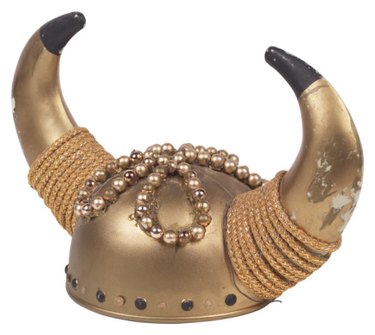Things You'll Need
Cattle horn
Water
Stewpot
Metal spoon
Heat-safe measuring cup
Dish liquid
Steel bristled scrub brush
Sandpaper: 80 grit to 600
Suede chamois
Jeweler’s cloth
Dark stout beer (cheap kind)
Natural cork

Vikings, like many other ancient peoples, derived everyday items from the materials around them. Since the ancient Norse kept cattle, many of their drinking vessels and storage containers were made from cattle horns. These horns may seem exotic to modern people, but the Vikings likely viewed them with little more awe than you view your coffee cup. Nevertheless, a drinking horn is essential for a Viking costume or a Norse-style feasting party. Since commercial drinking horns are expensive, you're better off fashioning your own.
Step 1
Find a horn free of cracks or chips. Look at the base of the horn; you should see a separation between the inner core and the outer rim. Rims thicker than 3/8 inch won't hold much liquid. The horn should also be relatively wide all the way down to the tip. This ensures you can clean it easily and it'll hold plenty of ale or mead.
Video of the Day
Step 2
Bring about 2 quarts of water to a boil in a large stewpot. Boil your horn for about 10 minutes and poke the inner core of the horn with a spoon. It should be soft and spongy. If not, boil it for an additional 5 minutes at a time until the core is soft.
Step 3
Scoop out the spongy inner core with a spoon and discard it. You may need to use successively smaller spoons to scoop the core out of the very tip of the horn; have patience and work slowly, scraping the sides of the horn thoroughly. Meticulous labor now will greatly extend the working life of your horn.
Step 4
Pour some clean, boiling hot water into a measuring cup and add a few sizeable squirts of dish liquid. Dip a bristled scrub brush into the water and scrub the inside of your horn with it. The brush must have dense bristles covering all sides and tip of the brush.
Step 5
Scrub and rinse your horn with soapy water about 15 times. Rinse it with warm, clean water about 10 times after scrubbing. Let the horn cool and dry overnight.
Step 6
Fill the horn to the top with cool water and sip a little. The water should taste clean and fresh, not bitter or chalky. Pour about 2/3 of the water from the horn and sip again; the water should still taste clean. If not, clean the horn again with a smaller scrub brush.
Step 7
Sand the outside of your cleaned horn with sandpaper, graduating from 80 grit paper all the way up to 600 grit paper. This gives your horn a smooth, silky, matte finish.
Step 8
Rub the horn down with a suede chamois and a jeweler's cloth, respectively. This should give your horn a high shine.
Step 9
Fill the horn with cheap, dark, stout beer. Set the horn upright in an empty stewpot for an hour. Check on the horn, refilling it if necessary. The beer should soak into the horn, curing it and making it harder and denser. Don't use your favorite beer; use something very cheap that you'd never drink.
Step 10
Cure the horn with beer for about 24 hours, until all the stout has soaked into the grain. Let the horn dry for 24 hours, fill it with water, and cap it with a natural cork.
Video of the Day